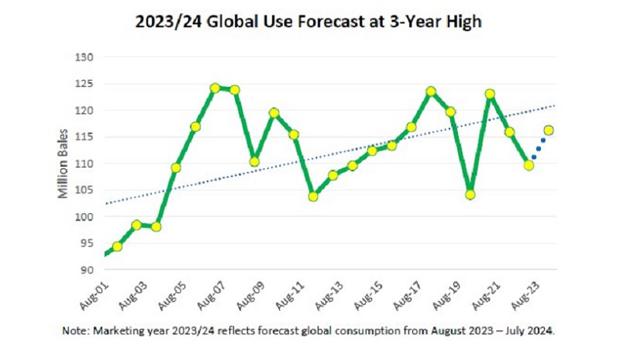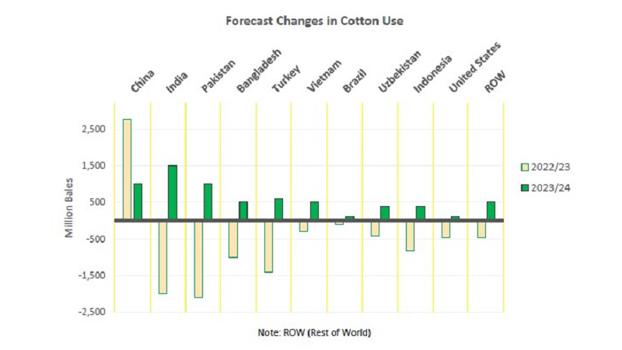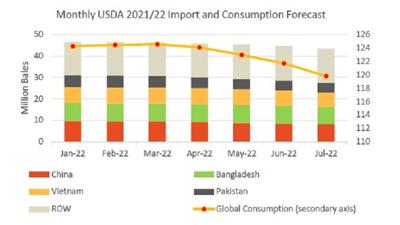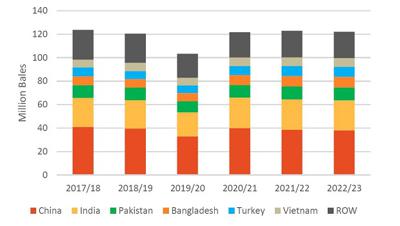
Global cotton consumption is forecast at 116.2 million bales for the season 2023/24, up more than 6.6 million from the previous year. Greater cotton supplies, lower producer price inflation, low global cotton yarn stocks, and greater margins for spinners are expected to boost future use. Consumption is forecast at the second highest level in 5 years and implies an annual growth rate of 6.0%, significantly higher than the long-term annual average of 1.5% since 1960/61. Still, consumption is projected below trend as macroeconomic headwinds and competition from chemical fibers continue to pressure global use.
These figures are part of the report “Cotton: World Markets and Trade” from the United States Department of Agriculture Foreign Agricultural Service (USDA), Washington, DC/USA.
The world’s 3 largest consumers – China, India, and Pakistan – are forecast to account for more than half of the global increase. Of the top 10 consuming countries, all are expected to have higher use. After significant reductions for India, Pakistan, and Bangladesh in the previous year, a general easing of financial pressures and greater supplies are expected to support consumption.
Higher cotton consumption is also supported by prospects for global economic growth. Cotton lint consumption and year-on-year changes in global Gross Domestic Product (GDP) are mostly correlated, however, cotton use and GDP do not always follow the same trend. The April 2023 World Economic Outlook published by the International Monetary Fund (IMF) projects global GDP to grow 2.8% for calendar year 2023 and 3.0% for 2024.
Since the 2006/07 consumption record of more than 124.0 million bales, competition with man-made fibers and macroeconomic challenges have pressured not only the level but the volatility of consumption. 
Another factor driving higher consumption is expected low inventories across the cotton product supply chain at the beginning of 2023/24. Disrupted and delayed shipments of consumer goods in calendar years 2021 and 2022 inflated global inventories and retailers responded with unusually large reductions in 2022/23 product orders. In addition, China’s lockdown orders starting in early 2022 also slowed consumption to unusually low levels.
Global mills’ operating rates have improved and are expected to continue into 2023/24 relative to the previous year. As the impacts of the pandemic further recede, inventory levels across the cotton product supply chain are expected to normalize and support higher use. Rising household savings accumulated during China’s Covid-19 lockdowns are also expected to support greater domestic purchases of cotton finished goods in one of the world’s most populous countries.
Uncertainties in the consumption outlook include the level of global cotton production, a persistent shift of consumer purchases to services and away from goods, and the unexpected impacts of global financial tightening in response to persistently high inflation. The ongoing Russian invasion of Ukraine has further contributed to uncertainty regarding global economic growth. This is particularly acute for Europe, as both the European Union (EU) and the United Kingdom (UK) are the world’s largest buyer of consumer products made from cotton fiber.
2023/24 Outlook
Production is mostly unchanged at 116.2 million bales, 300,000 lower compared with the previous year as declines in China and Turkey are mostly offset by larger crops in the USA and Pakistan. The small change in global production is partially owed to less competitive prices for cotton relative to other crops but this is offset by more favorable expected weather in major producing countries.
In January 2023, the A-Index was about one-third lower than a year prior, contributing to lower plantings of cotton across major producing countries. Despite lower plantings, harvested area in the USA is expected to rise as less acres are abandoned compared with the previous year’s record level. Greater production is also expected in Pakistan where unusually severe rainfall and flooding drove the previous year’s crop to the lowest level since 1983/84.
Global trade is forecast up roughly 5.0 million bales from the previous year to 42.8 million as higher exportable supplies and global consumption are expected to support greater world trade. China is projected to be the largest importer at 9.0 million bales after last year’s decline to 6.8 million. The country’s demand is expected to rise 1.0 million, owed to stronger private mill demand, higher prices for domestic cotton relative to imports, and supplies for state reserves. Of the top 5 importers, all are expected to witness growth due to greater consumption.
Global ending stocks are mostly unchanged at 92.4 million bales. Despite higher global consumption, drastically higher carry-in is projected to cap any significant fall in stocks. Stocks are projected above the 5-year average and are expected to prevent any significant rise in global cotton prices. The US season average farm price for 2022/23 is forecast at 78 cents, down 4 cents from the previous year.
2022/23 Outlook
Global production is up from the previous month to 116.5 million bales and attributed to higher production in China, Mexico, and Uzbekistan.
Consumption is lowered more than 500,000 bales to 109.6 million and attributed to lower use in Bangladesh and a historical revision to Burma.
Global imports are forecast down more than 900,000 from the previous month to 37.9 million bales, mostly on lower demand from Bangladesh and China. Exports are lowered for Brazil and India, reflecting a persistently slow pace of shipments.
Global ending stocks are forecast up nearly 700,000 bales to 92.7 million.
The US balance sheet includes lower production, higher exports, and lower ending stocks compared with last month. The projected US season-average farm price is forecast unchanged at 82 cents/pound.
The full 47-page report including graphs and charts is available from the USDA.



